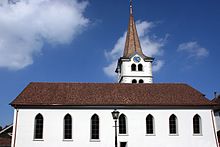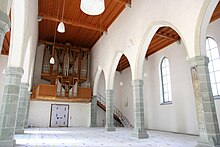St. Dionysius (Diessenhofen)
The Evangelical Church of St. Dionysius is the Evangelical - Reformed Church of Diessenhofen in the canton of Thurgau . Until the consecration of the Catholic Church Brother Klaus in 1967 it was used as a parity church.
Development and construction history
Diessenhofen is mentioned for the first time in the third oldest document that has survived in the canton of Thurgau. The document shows that on March 24, 757 a priest named Lazarus gave his own church together with the town of Deocincova to the abbot St. Otmar and the monastery of St. Gallen . The church was consecrated to St. Dionysius of Paris (Saint Denis), St. Blaise and St. Pancras . This patronage points to an early Christianization of the area around Diessenhofen. In the 13th century, a Romanesque basilica was built on the plan of today's church , which was struck by fire in 1363. In 1242 the pastor of Diessenhofen called beguines from Winterthur to serve the sick in Diessenhofen, whereupon the beguines founded the St. Katharinental monastery and accepted the rule of St. Dominic . At the time the city was founded in 1178, the Kyburgers owned the Diessenhof church as their own church. Probably due to the growing importance of the town with its Rhine crossing , the Romanesque basilica was converted into a representative three-aisled hall church around 1500 on the plan of the present church . The five Romanesque arches with their cube capitals were replaced in the nave by four pointed arch arcades with polygonal pillars . At the same time, the level of the ceiling was standardized and a gallery was installed at the west end of the main nave . In the pre-Reformation period, Diessenhofen had six chaplains , so that the thousand souls were looked after by eight clergymen .
When the people of Zurich and Unterwaldner conquered Thurgau in 1460, Nikolaus von Flüe personally protected the parish church and the St. Katharinental monastery from pillage. For this reason, the Catholic Church built in 1966–1967 was named after Nikolaus von Flüe .
1838–1839 Johann Nepomuk Keller and Jean Ruch changed the church interior in a neo-Gothic style: a pointed barrel hall was built in and the medieval rood screen was demolished. In 1897 and 1934–1935 the church was renewed outside and in 1903 inside. In the years 1968–1972 the architects Scherrer and Hartung carried out a complete renovation in which the church was given back the shape of the simple, Gothic relay hall. The church was extensively renovated in 2016.
Equal usage
Veit Kappeler was elected as the first Protestant pastor as early as 1519, but it was not until 1529 that the majority of the Diessenhof population changed to the new faith. Until the second country peace in 1531 there was no more Catholic mass in Diessenhofen. In 1533, at the request of a Catholic minority, a Catholic pastor again moved to Diessenhofen. In 1543 an altar was finally set up again for the Catholics. The simultaneous relationship lasted until the inauguration of the Catholic Church in Diessenhofen in 1967 .
In 1872, the civil parish handed over the town church to the Protestant and Catholic parishes. Both denominations were henceforth equally responsible for maintaining the church; The Catholics also took care of the preservation of the choir and the sacristy , both of which were reserved for the exclusive use of Catholics. When the church had to be renovated in the 1950s, the question arose whether the simultaneous relationship should be maintained. After lengthy negotiations, on April 4, 1963, the Protestant and Catholic parishes signed the contract of assignment from the city church to the Protestant parish.
Building description
Exterior and bells
The town church presents itself as a simple gable roof building with a choir flank tower . This extends with winged sandstone corner blocks to the pointed helmet , under which the double Gothic pointed arches open on all sides of the two-storey bell room. The previous two dials were supplemented by another two during the renovation in 1972 so that the time can be read from all sides. The bell cage hides a five-part chime that was cast in 1883 by the Keller bell foundry in Zurich and sounds in an B major chord: B - d flat - f sharp - b flat - d flat The five bells contain the following inscriptions: "Glory to God on high", "Peace on earth", "Stay with us, for evening will come", "Pray and work", "Let the little children come to me". The bells of the Catholic Church in Diessenhofen are matched to those of the Protestant Church.
Interior and artistic equipment
The church is accessed through the striking west entrance so that the visitor can see the central nave in front of them. To the south and north, the narrow aisles are attached to the wide central nave. Two rows of octagonal columns support the entire superstructure including the wooden ceiling over Gothic pointed arches. The east-facing choir is raised from the nave by stairs.
The oldest piece of equipment is the font from 1527. This came to light in the 1960s during archaeological investigations in the outer walls. Its fragments were added and put together. Since 2004 it has stood on the right in front of the choir room and is again used for baptismal rituals . The front of the Lord's Supper table is decorated with an epitaph from the 17th century that was originally attached to the wall . The epitaph shows a funeral ceremony of a noble family from the 17th century. The pulpit comes from the artist Emanuel Bosshard, Eschlikon and was made of solid walnut. It is adorned with a large crown, which symbolizes Jesus Christ , as well as smaller crowns, which stand for the disciples of Jesus . In the choir on the east wall and in the north wall, at the back of the staircase to the organ gallery, there are two modern glass windows created by Gian Casty (1914–1979). The larger window shows the disciple Peter , in whose net fish are caught. This refers to Peter's calling to be a fisherman of men. The stylized rooster is reminiscent of Peter's betrayal, and the stained glass also features doves and the tree of knowledge . The smaller glass picture in the north wall shows Elias with an angel.
Organs
Earlier organs
In 1643 the city of Diessenhofen sold an earlier organ for 60 guilders before the church was rebuilt. After the renovation, a new instrument was installed, which could have been made by Johann Jakob Mentzinger. In 1723 an unknown master built another instrument that had 5 stops. In 1726 Kaspar Radelmacher from Weil am Rhein added four more registers to the instrument. Until 1831 the organ was reserved for Catholic church services. In 1852, both denominations jointly acquired a large organ with 25 registers from Josef Braun, Spaichingen . Altar builder Müller from Wil SG supplied a neo-Gothic organ case. The previous organ from 1723 was sold to Randegg , Lower Austria. In 1891 Max Klingler redesigned the organ, which was replaced by a new instrument by Orgelbau Goll in 1935 . The organ from 1935 was an organ that had been built by Orgelbau Th. Kuhn in 1905 for the Bernese Pauluskirche . The pneumatic organ with 31 registers was built into the neo-Gothic case. This instrument was replaced by the current instrument in 1971.
Swiveling organ from 1972
During the renovation from 1968–1972, the earlier, much larger gallery, which had taken up the entire width of the western church space, was replaced by a smaller gallery. Today's organ was built on this in 1972. It comes from Curt Schwenkedel, Strasbourg , who built the instrument in stages. The organ has 4 manuals including a pedal with 31 registers; including Spanish trumpets (Chamadewerk). In 1995 and 1997, Späth Orgelbau , Rapperswil carried out an overhaul with minor changes, replacing the too thin-walled prospect pipes and changing the pedal mix. The Diessenhof organ is one of the larger in the canton and is a regional exception due to its Strasbourg sound characteristics.
|
|
|
|
|
||||||||||||||||||||||||||||||||||||||||||||||||||||||||||||||||||||||||||||||||
- Coupling : I-II, III-II, IV-II; I-P, II-P, III-P
- Shelf: tongues and mixtures
literature
- Evangelische Kirchgemeinde (ed.): In memory of the restoration 1968–1972. Diessenhofen 1972.
- Angelus Hux, Alexander Troehler: KlangRäume. Churches and organs in Thurgau. Frauenfeld 2007.
- Brigitta Lampert: Evangelical Church Diessenhofen. Diessenhofen 2015.
Web links
Individual evidence
- ↑ a b c d e Angelus Hux, Alexander Troehler: KlangRäume. Churches and organs in Thurgau , p. 134.
- ↑ Brigitta Lampert: Evangelical Church Diessenhofen , p. 2.
- ↑ Parish Diessenhofen (ed.): Brother Klausen Church Diessenhofen , pp. 8 and 10.
- ↑ Brigitta Lampert: Evangelical Church Diessenhofen , p. 2.
- ↑ Brigitta Lampert: Evangelical Church Diessenhofen , p. 2.
- ^ Parish Diessenhofen (ed.): Brother Klausen Church Diessenhofen , p. 10.
- ↑ Angelus Hux, Alexander Troehler: KlangRäume. Churches and organs in Thurgau , pp. 134–135.
- ^ Website of the Protestant parish Diessenhofen. Retrieved April 13, 2020.
- ↑ a b c d e f g Website of the Protestant parish. Retrieved April 4, 2020
- ↑ Evangelische Kirchgemeinde (ed.): In memory of the restoration 1968–1972 , pp. 10–11.
- ↑ Parish Diessenhofen (ed.): Brother Klausen Church Diessenhofen , pp. 15 and 24.
- ↑ Brigitta Lampert: Evangelical Church Diessenhofen , pp. 2 and 7.
- ^ Parish Diessenhofen (ed.): Brother Klausen Church Diessenhofen , p. 40.
- ↑ Brigitta Lampert: Evangelical Church Diessenhofen , p. 4.
- ↑ Brigitta Lampert: Evangelical Church Diessenhofen , p. 6.
- ↑ Brigitta Lampert: Evangelical Church Diessenhofen , p. 5.
- ↑ Brigitta Lampert: Evangelical Church Diessenhofen , p. 5.
- ↑ Angelus Hux, Alexander Troehler: KlangRäume. Churches and organs in Thurgau , pp. 135–136.
- ↑ Brigitta Lampert: Evangelical Church Diessenhofen , p. 6.
- ↑ Angelus Hux, Alexander Troehler: KlangRäume. Churches and organs in Thurgau , p. 136.



